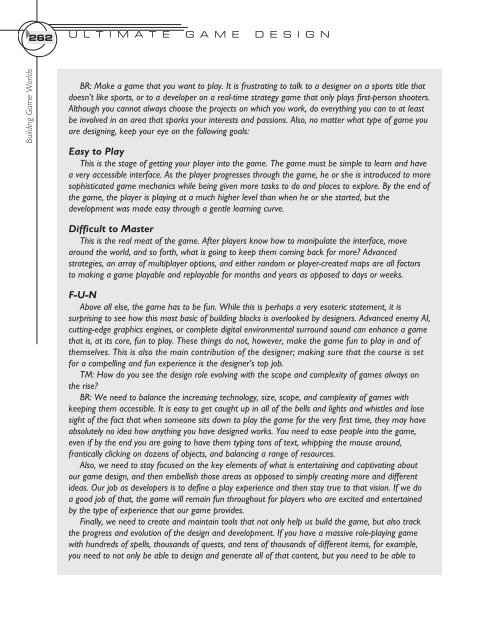Ultimate Game Design : Building game worlds
Ultimate Game Design : Building game worlds
Ultimate Game Design : Building game worlds
You also want an ePaper? Increase the reach of your titles
YUMPU automatically turns print PDFs into web optimized ePapers that Google loves.
<strong>Building</strong> <strong>Game</strong> Worlds<br />
262<br />
U L T I M A T E G A M E D E S I G N<br />
BR: Make a <strong>game</strong> that you want to play. It is frustrating to talk to a designer on a sports title that<br />
doesn’t like sports, or to a developer on a real-time strategy <strong>game</strong> that only plays first-person shooters.<br />
Although you cannot always choose the projects on which you work, do everything you can to at least<br />
be involved in an area that sparks your interests and passions. Also, no matter what type of <strong>game</strong> you<br />
are designing, keep your eye on the following goals:<br />
Easy to Play<br />
This is the stage of getting your player into the <strong>game</strong>. The <strong>game</strong> must be simple to learn and have<br />
a very accessible interface. As the player progresses through the <strong>game</strong>, he or she is introduced to more<br />
sophisticated <strong>game</strong> mechanics while being given more tasks to do and places to explore. By the end of<br />
the <strong>game</strong>, the player is playing at a much higher level than when he or she started, but the<br />
development was made easy through a gentle learning curve.<br />
Difficult to Master<br />
This is the real meat of the <strong>game</strong>. After players know how to manipulate the interface, move<br />
around the world, and so forth, what is going to keep them coming back for more? Advanced<br />
strategies, an array of multiplayer options, and either random or player-created maps are all factors<br />
to making a <strong>game</strong> playable and replayable for months and years as opposed to days or weeks.<br />
F-U-N<br />
Above all else, the <strong>game</strong> has to be fun. While this is perhaps a very esoteric statement, it is<br />
surprising to see how this most basic of building blocks is overlooked by designers. Advanced enemy AI,<br />
cutting-edge graphics engines, or complete digital environmental surround sound can enhance a <strong>game</strong><br />
that is, at its core, fun to play. These things do not, however, make the <strong>game</strong> fun to play in and of<br />
themselves. This is also the main contribution of the designer; making sure that the course is set<br />
for a compelling and fun experience is the designer’s top job.<br />
TM: How do you see the design role evolving with the scope and complexity of <strong>game</strong>s always on<br />
the rise?<br />
BR: We need to balance the increasing technology, size, scope, and complexity of <strong>game</strong>s with<br />
keeping them accessible. It is easy to get caught up in all of the bells and lights and whistles and lose<br />
sight of the fact that when someone sits down to play the <strong>game</strong> for the very first time, they may have<br />
absolutely no idea how anything you have designed works. You need to ease people into the <strong>game</strong>,<br />
even if by the end you are going to have them typing tons of text, whipping the mouse around,<br />
frantically clicking on dozens of objects, and balancing a range of resources.<br />
Also, we need to stay focused on the key elements of what is entertaining and captivating about<br />
our <strong>game</strong> design, and then embellish those areas as opposed to simply creating more and different<br />
ideas. Our job as developers is to define a play experience and then stay true to that vision. If we do<br />
a good job of that, the <strong>game</strong> will remain fun throughout for players who are excited and entertained<br />
by the type of experience that our <strong>game</strong> provides.<br />
Finally, we need to create and maintain tools that not only help us build the <strong>game</strong>, but also track<br />
the progress and evolution of the design and development. If you have a massive role-playing <strong>game</strong><br />
with hundreds of spells, thousands of quests, and tens of thousands of different items, for example,<br />
you need to not only be able to design and generate all of that content, but you need to be able to

















